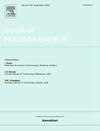堆芯的容器外稳定:硅质混凝土顶部水浸与堆芯-混凝土相互作用的分析
IF 2.3
3区 工程技术
Q1 NUCLEAR SCIENCE & TECHNOLOGY
引用次数: 0
摘要
如果发生严重事故而不可能在容器内滞留,堆芯必须在扩散后稳定在容器外,要么在设计的堆芯捕集器中,要么直接在反应堆建筑的混凝土基础上。在最后一种情况下,稳定策略必须足够有效,以避免堆芯通过混凝土基底和环境的进展。为了确保堆芯的稳定,与混凝土的侵蚀相比,导致部分液态堆芯冷却的物理过程必须足够快。一种可能的策略是将堆芯扩散到一个相当大的区域(即反应堆坑加上一个或两个相邻的房间),并在顶部注水。通过实验确定了两个过程:熔体喷发和水侵。熔体喷发是一个由混凝土侵蚀产生的气体流(CO2和H2O)驱动的过程:气体流很可能将堆芯的液滴带入上面的水中,使液滴迅速熄灭。水侵是由于顶部地壳因冷却而收缩而产生裂缝的过程:这一过程使水流进入裂缝,并使裂缝前缘深入到堆芯地壳中。当基底由硅质混凝土构成时,稳定主要取决于水的渗入,因为这种混凝土中几乎没有气体含量,熔体喷发可能只有有限的影响。本文分析了为了减少扩散后堆芯的厚度,将堆芯分散在相当大的区域(约80平方米)的情况。当然,这个厚度取决于反应堆的设计(堆芯的总体积除以总扩散面积)。扩散后,堆芯在顶部被水淹没。首先,对熔体喷发过程进行了研究,结果表明,在硅质混凝土中,熔体喷发的效率有限,但在早期引发水侵方面起着重要作用。然后,检查了水的侵入过程,因为它是导致完全稳定的过程。入水提取的最大热通量是这一过程中最重要的参数,需要准确评价。因此,根据现有的李斯特-爱泼斯坦模型、早先在阿贡国家实验室获得的数据以及在火山岩中测量的数据,对CHF作为堆芯中混凝土含量的函数进行了理论上的确定。此外,提出了一种简单的混凝土基底瞬态热传导模型,以确定可以用于集总参数代码的侵蚀停止准则。结果表明,堆芯的淬火可分为两个主要阶段。第一阶段的特点是混凝土的快速侵蚀和大量的喷发和碎片的熄灭。这个阶段持续半天到几天,取决于混凝土的类型和模型参数。第二阶段的特点是混凝土的缓慢侵蚀和水侵入的开始。这个阶段可能会持续半天到一周,具体取决于混凝土的类型和模型参数。最后,进行了敏感性分析,以确定对侵蚀深度和稳定时间的影响。在堆芯混凝土相互作用初期,水侵效率对熔体喷发的发生具有重要的依赖性。熔体喷发,即使是有限的,也可能显著增强水侵入的触发,有利于堆芯的快速稳定。本文章由计算机程序翻译,如有差异,请以英文原文为准。
Ex-vessel stabilization of corium: An analysis of corium-concrete interaction with top flooding for siliceous concrete
In case of severe accident without possibility of in-vessel retention, the corium must be stabilized outside the vessel, either in a designed core-catcher or directly on the concrete basemat of the reactor building, after spreading. In this last case, the stabilization strategy must be efficient enough to avoid the progression of corium through the concrete basemat and to the environment.
In order to ensure corium stabilization, the physical processes leading to quench some part of the liquid corium must be fast enough, compared to the erosion of concrete. One of the possible strategies consists in spreading the corium over a rather large area (i.e. the reactor pit plus one or two adjacent rooms) and flood it with water on top. Two processes have been identified experimentally for a potential quenching of corium: melt eruption and water ingression. Melt eruption is a process that is driven by the flow of gases (CO and HO) generated by concrete erosion: the gas flow is likely to entrain droplets of corium into the overlying water, quenching the droplets quickly. Water ingression is a process where cracks are generated by the contraction of the top crust due to cooling: this process enables the flow of water into the cracks and the propagation of the cracking front deep into the corium crust. When the basemat is made of siliceous concrete, stabilization depends mostly on water ingression because there is little gas content in such concrete and melt eruption may only have a limited effect.
This paper presents the analysis of a situation where corium is spread over a rather large area (around 80 m) in order to reduce the corium thickness after spreading. Of course, this thickness depends on the reactor design (total volume of corium divided by total spreading area). After spreading, corium is flooded with water on top. First, the melt eruption process is investigated: it is shown that it has a limited efficiency in case of siliceous concrete but it plays an important role in triggering the water ingression earlier. Then, the process of water ingression is examined, as it is the process leading to complete stabilization. The maximum heat flux extracted by water ingression (CHF) is the most important parameter in this process and needs to be evaluated accurately. Therefore, a theoretical determination of the CHF is made, as a function of the concrete content in the corium, based on the existing Lister-Epstein model, on data obtained earlier at Argonne National Laboratory and on data measured in volcanic rocks. In addition, a simple modeling of transient heat conduction through the concrete basemat is proposed, to determine a criterion of stop of erosion that can be used in a lumped-parameter code. As a conclusion, it is shown that the quenching of corium may be divided in two main stages. The first stage is characterized by a fast erosion of concrete and a significant eruption and quenching of debris. This stage lasts from half a day to a few days, depending on the type of concrete and on the model parameters. The second stage is characterized by a slower erosion of concrete and the start of water ingression. This stage may last from half a day up to one week depending on the type of concrete and on the model parameters. Finally, a sensitivity analysis is made to determine the effects on the erosion depth and on the time of stabilization. It appears that there is a non-trivial dependence of water ingression efficiency on the occurrence of melt eruption at the very beginning of corium concrete interaction. Melt eruption, even if limited, is likely to significantly enhance the triggering of water ingression and favor a fast stabilization of corium.
求助全文
通过发布文献求助,成功后即可免费获取论文全文。
去求助
来源期刊

Annals of Nuclear Energy
工程技术-核科学技术
CiteScore
4.30
自引率
21.10%
发文量
632
审稿时长
7.3 months
期刊介绍:
Annals of Nuclear Energy provides an international medium for the communication of original research, ideas and developments in all areas of the field of nuclear energy science and technology. Its scope embraces nuclear fuel reserves, fuel cycles and cost, materials, processing, system and component technology (fission only), design and optimization, direct conversion of nuclear energy sources, environmental control, reactor physics, heat transfer and fluid dynamics, structural analysis, fuel management, future developments, nuclear fuel and safety, nuclear aerosol, neutron physics, computer technology (both software and hardware), risk assessment, radioactive waste disposal and reactor thermal hydraulics. Papers submitted to Annals need to demonstrate a clear link to nuclear power generation/nuclear engineering. Papers which deal with pure nuclear physics, pure health physics, imaging, or attenuation and shielding properties of concretes and various geological materials are not within the scope of the journal. Also, papers that deal with policy or economics are not within the scope of the journal.
 求助内容:
求助内容: 应助结果提醒方式:
应助结果提醒方式:


